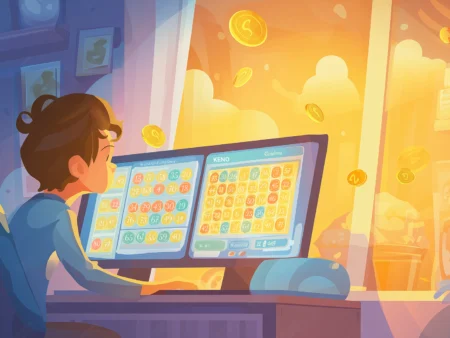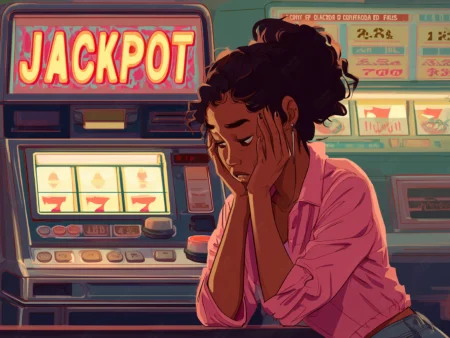Some players swear by number patterns. Others cling to “hot” numbers fresh off recent draws. And then there are the birthday loyalists, always picking 7, 11, or whatever date feels lucky.
But when you’re sitting in front of a keno grid, whether it’s live, digital, or fast-paced video keno, one question always comes up:
Do certain numbers actually give you a better shot at winning?
Short answer? Not really.
But if you stop there, you miss what makes keno so endlessly debated, and weirdly addictive.
For a simple game, keno invites a lot of overthinking. Players chase streaks, track draw histories, and pass around so-called “winning systems.” Some of it’s harmless superstition. Some of it’s bad math. Most of it overlooks the one edge that does matter: understanding how the game pays, and how your picks fit into that puzzle.
So if you’ve ever chased hot numbers or wondered whether lucky 13 is a blessing or a curse, you’re not alone. In this guide, we’ll break down what the stats say, where the myths come from, and how to approach the “best keno numbers” question like a player who knows the game behind the game.
Table of contents
- What Are the Best Keno Numbers, And Do They Even Exist?
- How Keno Numbers Are Actually Drawn (The Math + Mechanics)
- Does Picking Certain Numbers Help Your Odds?
- How to Play Smart (Even If the Game’s Random)
- TL;DR, What Actually Matters When Picking Keno Numbers
- FAQs About Keno Numbers and Patterns
- Want to Put Your Keno Numbers to the Test?
What Are the Best Keno Numbers, And Do They Even Exist?
You’ve probably heard someone claim they always hit with 7, 11, or 69. Maybe you’ve seen charts online ranking the most drawn keno numbers. The idea that certain numbers hit more often is hard to ignore, it’s wired into how we think about luck and probability.
But when it comes to keno, do any of those patterns actually hold up?
Let’s break down where these beliefs come from, and what the real data says.
The Allure of “Hot” and “Cold” Numbers
Keno players love their patterns. Hot numbers, the ones drawn most frequently, feel like a shortcut to a win. Cold numbers? Some players swear they’re “due.”
It sounds logical enough: if a number has popped five times this week, it’s probably going to hit again… right?
That logic shows up everywhere, keno halls, Reddit threads, Telegram chats. People screenshot results, build spreadsheets, and hunt for “hot zones.” And sure, some sites track frequently drawn numbers across thousands of games.
But here’s the catch: those stats aren’t predictive.
It’s like chasing a slot that just dropped a jackpot. Just because something hit recently doesn’t mean it’s going to stay hot. In fact, in a properly run keno game, every draw is independent, and past results have zero effect on future outcomes.
The brain sees patterns. The RNG doesn’t.
Most Drawn Keno Numbers (What the Stats Say)
Still, plenty of players use draw frequency as a guide. Here’s an example, pulled from a provider’s multi-game data set, tracked over thousands of online draws:
| Rank | Number | Drawn % (Approx.) |
| 1 | 1 | 2.25% |
| 2 | 4 | 2.25% |
| 3 | 23 | 2.24% |
| 4 | 34 | 2.23% |
| 5 | 72 | 2.23% |
| 6 | 35 | 2.22% |
| 7 | 65 | 2.22% |
| 8 | 50 | 2.21% |
| 9 | 3 | 2.21% |
| 10 | 12 | 2.20% |
These most drawn keno numbers might look like winners, and they’re popular for a reason. But don’t mistake trend for truth. The RNG doesn’t remember. It doesn’t track patterns. It just spins.
So if you enjoy tracking hot numbers for fun? Go for it.
Some players believe certain patterns repeat, here’s what we’ve seen in real-world keno sessions.
How Keno Numbers Are Actually Drawn (The Math + Mechanics)
Let’s cut through the noise. Before you chase the best keno numbers or ride a hot streak, you need to understand how those numbers are even picked. Because once you know what’s going on under the hood, you’ll stop chasing shadows, and start playing with sharper expectations.
How Do Keno Numbers Get Picked?
In any regulated online keno game, each draw is powered by a random number generator (RNG), a certified algorithm that gives every number from 1 to 80 an equal chance of being drawn. No memory. No patterns. No “streaks.”
These RNGs are tested and certified by independent labs like GLI (Gaming Laboratories International) and iTech Labs, ensuring fairness and randomness. So no, you’re not up against a rigged system. You’re up against pure probability.
The takeaway? You can’t predict the outcome, but you can choose how you play.
Keno Machines vs. Live Draws: Same Outcome, Different Format
You’ll usually find two types of keno online:
- Video Keno: Fast-paced, solo play powered entirely by RNGs.
- Live Keno: Streamed in real-time with physical ball machines, but still audited and regulated for fairness.
Live keno might feel more like the lottery, and video keno might remind you of a slot game. But both are built on the same principle: randomness backed by regulation.
If you’re playing at a licensed online casino, the format doesn’t change your odds. There’s no system to beat, no timing trick, and no secret formula.
No Secret Algorithms. No Hacks. No Beatable Patterns.
It’s tempting to believe there’s a code to crack. A rhythm to read. A trick buried deep in the machine’s logic.
There isn’t.
Keno’s odds are built into the structure of the game. The math is designed to be random, and profitable for the house. Your job isn’t to hack it, it’s to understand your risk, pick smart paytables, and manage how you play.
What you can control is how many numbers you choose, how volatile the payouts are, and what type of keno variant you’re playing.
Before you pick numbers, know what each hit actually pays, your payout odds might surprise you.
Sidebar: RTP Ranges in Online Keno
| Keno Variant | RTP Range |
| Standard Video Keno | 92% – 95% |
| Multi-card Keno | 93% – 96% |
| Keno with Bonus Round | 91% – 94% |
| Progressive Jackpot Keno | 88% – 92% |
Note: Some versions include multipliers or side bets, great for excitement, but they often lower the base RTP. Always check the info panel before you hit play.
Does Picking Certain Numbers Help Your Odds?
Let’s be honest: every keno player has a system, or at least a superstition. Maybe it’s your kid’s birthday. Maybe it’s a cluster that “feels right.” Maybe you always avoid 13 because, well… why risk it?
The belief that certain numbers can give you an edge is everywhere. But if you’re here wondering whether specific picks actually improve your odds?
Short answer: they don’t.
That said, how you choose your numbers does shape your play experience, and can influence how often you hit small wins, how engaged you feel, or how disciplined your sessions are. So let’s break it down.
The “Lucky Numbers” Strategy
This is by far the most common approach. Players often pick:
- Birthdays and anniversaries (1–31 show up often on keno grids)
- Culturally lucky numbers, like 7, 8, or 3
- Avoided numbers (4 and 13 are snubbed in some cultures)
There’s nothing wrong with this, personal numbers add meaning and make the game more fun. But here’s the truth:
The RNG doesn’t care about your lucky digits.
If 17 hasn’t hit in 15 draws, it’s not “due.” And if your birthday pops twice in one session, it’s not divine intervention, it’s just variance.
So sure, play your numbers. But don’t mistake nostalgia or symbolism for a strategy.
Number Clustering and Balanced Grids
Some players take a more “tactical” approach by building grids with number clusters or evenly spread picks. For example:
- Cluster A: 1–10
- Cluster B: 31–40
- Balanced spread: 10 numbers spaced across the board
The theory here is that covering different zones increases your chances or smooths out risk.
In reality? It doesn’t change your odds at all.
Clustering doesn’t reduce variance. Spreading your picks doesn’t boost hit rate. The RNG sees numbers, not patterns.
Still, if you enjoy visual symmetry or like organizing your plays visually, go for it. Just don’t expect it to move the needle.
Random Picks vs Thought-Out Selections
Online keno makes it easy to go with:
- Quick picks
- Auto-play setups
- “Surprise me” modes
Choosing numbers at random can:
- Save time
- Remove emotional bias
- Keep gameplay fast and fluid, especially on mobile or casual sessions
Your odds stay the same either way. Whether you spend 10 minutes picking or let the game choose for you, the RNG resets every draw.
One exception? If you’re chasing features, like multipliers or bonus rounds, quick pick is perfect. It keeps you in the game without the mental gymnastics.
How to Play Smart (Even If the Game’s Random)
Keno is built on randomness, but that doesn’t mean you’re powerless. While you can’t influence the draw, you can control how you play.
And that’s where the sharp players pull ahead.
Whether you’re in it for the rush of a 10-hit card or trying to stretch your bankroll across a full session, here’s how to play smarter, and get more out of every round.
1. Know the Paytables, They’re Not All Equal
The #1 mistake new players make? Ignoring the paytable.
Every keno variant has a unique payout structure. Some reward 6 hits with solid returns. Others skew heavily toward rare 9 or 10-spot wins, where the odds are sky-high but the payout’s massive.
Example: If a game pays 2x for 4 hits but barely anything for 5, you’re better off targeting 4-spot picks than wasting bets chasing an underpaid 5.
Always check the game info or rules before you click “play.”
Before you pick numbers, know what each hit actually pays, it could completely change your strategy.
2. Stick to 4–6 Numbers for Balanced Risk/Reward
Yes, you can pick all 10 numbers. And yes, hitting all 10 would be incredible.
But here’s the math: the odds of hitting 10/10 are around 1 in 8.9 million.
If you’re aiming for consistent play and semi-regular wins, the sweet spot is picking 4 to 6 numbers. It balances risk and reward better than most setups.
Here’s how it breaks down:
- Pick 1–3: Higher chance of a small hit, but low payouts
- Pick 4–6: Best mix of win frequency and reasonable rewards
- Pick 7–10: Huge payouts, but you’ll almost never hit enough to get there
Want to stay in the game longer and still enjoy some spike potential? Go with 5.
Manage Your Bankroll Like It’s Blackjack
Keno moves fast, especially on auto-play or turbo rounds. That speed can drain your balance before you realize what happened.
Set a budget. Break it down by number of rounds. Choose bet sizes that give you room to breathe. And if you’re in for the long haul, lower stakes = more play time.
Pro tip: Treat bonus wins as a reload, not a reason to triple your next bet.
Play Keno Versions with Multipliers or Bonus Features
Not all keno games are created equal. Some pack in extra mechanics that add excitement and upside:
- Multipliers: Random boosts that can double or triple wins
- Bonus rounds: Bullseye targets, second chance picks, or jackpot triggers
- Side bets: Optional wagers with high variance (and high risk)
These don’t change the underlying odds, but they do increase your potential payout per spin.
Try these high-RTP or multiplier-based keno sites and test your strategy
If you’re picking numbers anyway, pick the version that pays better when you hit.
TL;DR, What Actually Matters When Picking Keno Numbers
Let’s strip it down to what actually moves the needle.
There’s no magic combo. The “best keno numbers” don’t exist in any real mathematical sense. Every number has the same odds. Every draw is random. And chasing hot or cold numbers won’t outsmart the RNG.
But what does impact your session?
- The paytable. Some games punish low hits, others reward 4–6-spot strategies. If you’re not checking the payout chart, you’re flying blind.
- The number of spots you choose. Picking 4 to 6 numbers often hits the sweet spot, enough action without burning your bankroll chasing long shots.
- The version you’re playing. Games with multipliers, bullseyes, or higher RTPs can stretch your value per spin, even if the base odds stay the same.
- Your bankroll strategy. You don’t control the outcome of each draw, but you do control how long you’re in the game. Bet accordingly.
And hey, if you still want to chase 23 because it’s “hot” or stick with that lucky birthday combo?
Go for it. Just treat it like a ritual, not a strategy.
FAQs About Keno Numbers and Patterns
All numbers have the exact same odds of being drawn, that’s how a true RNG (random number generator) works. Over time, some numbers may appear more frequently, but that’s just variance, not evidence of a pattern. The house doesn’t favor any number.
No legitimate keno game has a “secret” pattern you can exploit. What players call patterns are usually just statistical noise or coincidence. Licensed games are designed to be random, not readable, no system or formula will change that.
You can’t change the odds, but you can play smarter. Stick to 4–6 number picks for balance, choose games with solid paytables or multipliers, and manage your bankroll. The best “strategy” is knowing what pays and avoiding common traps like chasing hot streaks.
Yes, but it’s incredibly rare. Hitting 10 out of 10 happens roughly once in 8.9 million plays, depending on the game. Hitting 12 is even tougher. These are lottery-level odds, so if it happens, enjoy it, but don’t build your game plan around it.
There’s no universal set of lucky numbers. That said, based on long-term draw data from popular online keno providers, numbers like 1, 4, 11, 23, 34, and 72 show up more often than others. But remember: past performance doesn’t predict future results, the RNG doesn’t care about history.
Want to Put Your Keno Numbers to the Test?
You’ve got the insights. You know the myths. You understand the odds.
Now it’s time to take what you’ve learned and see how your numbers perform in the real world.
Ready to test your lucky picks?
Explore our top-rated Keno games, check the latest bonuses, and play smart, whether you’re chasing hot numbers, sticking with your grid, or just in it for the fun.
Remember, it’s not about beating the system. It’s about playing with purpose, knowing the mechanics, and making every draw count.












































